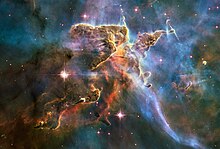Jeans criterion
The jeans criterion of star formation (after James Jeans ), also Jean's criterion , says that a cosmic gas cloud collapses and a star can ultimately emerge from it if its mass is greater than the mass of jeans . If the gas cloud is a protoplanetary disk , the Jeans criterion can also be used for the formation of gas planets .
Under terrestrial conditions, gases spread evenly in the available space due to the kinetic energy of the molecules and their associated collisions. In free space, on the other hand, larger accumulations of gases are held together by gravity and are therefore spatially limited. After exceeding the jeans mass, the cloud continues to contract until a new state of equilibrium is reached (star formation).
Calculation or estimation of the jeans mass
The jeans mass as the minimum limit mass can be estimated as follows:
With
- a numerical prefactor that depends on the estimate and its accuracy
- further variables, which are explained below.
A spherical gas cloud of the mass , the homogeneous density , the calculated radius and the temperature are assumed. No external forces act on the gas cloud, it does not rotate, and the gas behaves like an ideal gas .
The cloud begins to collapse if the contracting gravitational forces are greater than the stabilizing force of the gas pressure (Jeans criterion). This state is reached when the mass of the gas cloud exceeds the corresponding jeans mass at a certain density and temperature. It can be determined both from the balance of pressures and from that of the energies.
About the equilibrium pressure
If the pressures in the center of the cloud are balanced:
From the ideal gas equation
and follows the gravitational pressure inside a sphere
With
- the pressure
- the volume
- the number of gas molecules
- the Boltzmann constant
- the absolute temperature
- the mass of the individual gas molecule
- the gravitational constant .
This results in:
- .
The numerical prefactor is here .
About the energy balance
In the energy equilibrium approach, the kinetic energy is as follows after using the virial theorem for the gravitational binding energy of the gas cloud:
or with :
The dissolution after leads to the following jeans mass:
So a numerical prefactor .
Another derivation of Jeans, based on the diameter and density of the cloud and the speed of sound of an ideal gas, gives .
Influence of density and temperature
As can be seen from the formulas, the jeans mass is smaller for cold gas clouds than for hot ones, but higher for low gas densities. The diagram on the right shows the dependence of different jeans sizes on density and temperature. The jeans mass is given as a multiple of the solar mass, as the gas, monatomic hydrogen gas was chosen as the most common element in the universe (mass per atom: µ ≈ 1.67e-27 kg). The calculation was carried out as stated above using the pressure equilibrium; the calculation using the energy balance would lead to a slightly different result, but both approaches are greatly simplified approximations.
Reading example: A cloud of monatomic hydrogen gas of 10 solar masses and a density of 10 −17 kg ⋅m −3 collapses at a temperature of ≤ 10 K. To illustrate, such a cloud would have about 6000 atoms per cm³ and a diameter of 1, 65 light years ( 1.56e13 kilometers).
Literature and Sources
- Bradley W. Carroll, Dale A. Ostlie: An introduction to Modern Astrophysics . 1996, ISBN 0-321-21030-1 , pp. 449 .
- Hermann Kolanoski: Introduction to Astroparticle Physics. (PDF; 13.8 MB) Accessed July 21, 2013 .
- Malcolm S. Longair : Galaxy Formation . Springer, Berlin, 1998, ISBN 3-540-63785-0 . ( Astronomy and Astrophysics Library ).
- Roman Sexl , Hannelore Sexl: White dwarfs - black holes. Introduction to relativistic astrophysics. 2nd expanded edition. Vieweg Verlag, Braunschweig 1999, ISBN 3-528-17214-2 (Vieweg study - basic physics course).
- Albrecht Unsöld , Bodo Baschek: The new cosmos . 4th completely revised edition. Springer, Berlin 1988, ISBN 3-540-18171-7 .



























